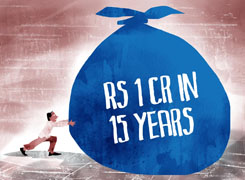Ramalingam Kalirajan |10874 Answers |Ask -Follow
Mutual Funds, Financial Planning Expert - Answered on Jul 03, 2024
He has an MBA in finance from the University of Madras and is a certified financial planner.
He is the director and chief financial planner at Holistic Investment, a Chennai-based firm that offers financial planning and wealth management advice.... more

Currently I am working and having 14 lac in ppf, mutual fund 27lac, shares I have 10 lacs, other investment around 10 lacs. I don't have own house staying with my parents. Currently earning around 1.5 lac month. My current age is 39, want to retire next year. Can you please advise how to generate income for my family having 2 kids and wife.
Assessing Your Current Financial Situation
PPF (Public Provident Fund)
Your PPF account has Rs 14 lakh. PPF is a safe and tax-efficient investment but has a lock-in period of 15 years. It provides steady returns but limited liquidity.
Mutual Funds
With Rs 27 lakh in mutual funds, you have exposure to market-linked returns. Mutual funds offer growth potential but come with market risks.
Shares
Your Rs 10 lakh investment in shares indicates a higher risk tolerance. Shares can provide high returns but also come with volatility.
Other Investments
Your other investments total Rs 10 lakh. These could include a mix of fixed deposits, bonds, or other financial instruments, providing stability and diversification.
Income Generation Strategies Post-Retirement
Systematic Withdrawal Plan (SWP) from Mutual Funds
An SWP allows you to withdraw a fixed amount regularly from your mutual fund investments. This can provide a steady income stream while keeping your principal invested for growth.
Dividend-Paying Stocks and Mutual Funds
Invest in dividend-paying stocks and mutual funds. These provide regular income in the form of dividends, supplementing your cash flow needs.
Monthly Income Plans (MIPs)
MIPs are mutual funds that invest in debt and equity, aiming to provide regular income. They are less risky than pure equity funds and can offer steady returns.
Senior Citizens' Savings Scheme (SCSS)
Once you turn 60, consider SCSS for a safe and regular income source. It offers attractive interest rates and is backed by the government.
Debt Mutual Funds
Investing in debt mutual funds can provide stable returns with lower risk compared to equity funds. These funds invest in bonds and fixed-income securities.
Fixed Deposits (FDs)
Fixed deposits provide guaranteed returns with high safety. Although the returns are lower compared to equity, they offer stability and security.
Planning for Children's Education and Family Expenses
Children's Education Fund
Start a dedicated investment fund for your children's education. Equity mutual funds or balanced funds can be suitable for long-term growth.
Emergency Fund
Maintain an emergency fund equivalent to 6-12 months of expenses. This ensures liquidity for unforeseen expenses without disrupting your investments.
Health Insurance
Ensure you have adequate health insurance coverage for yourself and your family. Medical emergencies can be financially draining without proper insurance.
Managing Expenses and Budgeting
Expense Tracking
Track your monthly expenses meticulously. Identify areas where you can cut down costs without compromising your lifestyle.
Budget Planning
Create a detailed budget for post-retirement expenses. Include all necessary expenses such as household, education, medical, and discretionary spending.
Lifestyle Adjustments
Consider lifestyle adjustments to align with your new income level post-retirement. Small changes can lead to significant savings.
Risk Management and Diversification
Diversified Portfolio
Maintain a diversified portfolio to spread risk. Invest across different asset classes like equity, debt, and balanced funds.
Regular Portfolio Review
Review your investment portfolio regularly. Market conditions change, and it’s crucial to rebalance your portfolio to stay aligned with your goals.
Tax Planning and Optimization
Tax-Efficient Investments
Invest in tax-efficient instruments like ELSS (Equity-Linked Savings Scheme) for tax savings under Section 80C. Optimize your portfolio to minimize tax liabilities.
Retirement Corpus Withdrawal Strategy
Plan your withdrawal strategy to minimize tax impact. Withdraw from tax-exempt sources like PPF and use tax-efficient SWPs.
Seeking Professional Guidance
Certified Financial Planner (CFP)
Working with a CFP provides personalized advice and strategic planning. A CFP can help you navigate financial decisions and optimize your investment strategy.
Financial Workshops and Seminars
Attend financial workshops and seminars to stay updated on investment strategies and market trends. Continuous learning can enhance your financial acumen.
Creating a Legacy and Estate Planning
Will and Estate Planning
Draft a will to ensure your assets are distributed as per your wishes. Estate planning is crucial to provide financial security to your family.
Nomination and Beneficiaries
Ensure all your investments have the correct nomination details. This simplifies the process for your family in case of any eventuality.
Final Insights
Planning to retire at 40 with a family to support requires meticulous financial planning. Your current investments in PPF, mutual funds, shares, and other instruments provide a strong foundation. To generate regular income post-retirement, consider strategies like Systematic Withdrawal Plans (SWP) from mutual funds, dividend-paying stocks, Monthly Income Plans (MIPs), and debt mutual funds.
Maintain an emergency fund and ensure adequate health insurance coverage. Budget planning and expense tracking are essential to align your lifestyle with your new income level. Regularly review and rebalance your portfolio to stay on track with your financial goals.
Working with a Certified Financial Planner (CFP) can provide valuable guidance and optimize your investment strategy. Consider tax-efficient investments and plan your withdrawals to minimize tax impact. Estate planning and drafting a will ensure your family's financial security.
Your disciplined approach to savings and investments, combined with strategic planning, will help you achieve financial stability post-retirement. Stay focused on your goals, and with the right strategies, you can secure a comfortable and fulfilling retirement for yourself and your family.
Best Regards,
K. Ramalingam, MBA, CFP,
Chief Financial Planner,
www.holisticinvestment.in
You may like to see similar questions and answers below
Ramalingam Kalirajan |10874 Answers |Ask -Follow
Mutual Funds, Financial Planning Expert - Answered on May 17, 2024
Ramalingam Kalirajan |10874 Answers |Ask -Follow
Mutual Funds, Financial Planning Expert - Answered on May 16, 2024
Milind Vadjikar | Answer |Ask -Follow
Insurance, Stocks, MF, PF Expert - Answered on Sep 19, 2024
Ramalingam Kalirajan |10874 Answers |Ask -Follow
Mutual Funds, Financial Planning Expert - Answered on Aug 16, 2024
Naveenn Kummar |233 Answers |Ask -Follow
Financial Planner, MF, Insurance Expert - Answered on Sep 04, 2025
Mayank Chandel |2567 Answers |Ask -Follow
IIT-JEE, NEET-UG, SAT, CLAT, CA, CS Exam Expert - Answered on Dec 08, 2025
Mayank Chandel |2567 Answers |Ask -Follow
IIT-JEE, NEET-UG, SAT, CLAT, CA, CS Exam Expert - Answered on Dec 08, 2025
Mayank Chandel |2567 Answers |Ask -Follow
IIT-JEE, NEET-UG, SAT, CLAT, CA, CS Exam Expert - Answered on Dec 08, 2025
Mayank Chandel |2567 Answers |Ask -Follow
IIT-JEE, NEET-UG, SAT, CLAT, CA, CS Exam Expert - Answered on Dec 08, 2025
Anu Krishna |1746 Answers |Ask -Follow
Relationships Expert, Mind Coach - Answered on Dec 08, 2025
Ramalingam Kalirajan |10874 Answers |Ask -Follow
Mutual Funds, Financial Planning Expert - Answered on Dec 08, 2025
Samraat Jadhav |2499 Answers |Ask -Follow
Stock Market Expert - Answered on Dec 08, 2025
Ramalingam Kalirajan |10874 Answers |Ask -Follow
Mutual Funds, Financial Planning Expert - Answered on Dec 08, 2025
Radheshyam Zanwar |6737 Answers |Ask -Follow
MHT-CET, IIT-JEE, NEET-UG Expert - Answered on Dec 08, 2025
Nayagam P P |10852 Answers |Ask -Follow
Career Counsellor - Answered on Dec 07, 2025

Research Career Prospects: IISc, IITs, and Beyond: For research-oriented careers, the Integrated M.Sc Physics program at Amrita provides an exceptional foundation. Amrita's curriculum specifically aligns with GATE and UGC-NET examination syllabi, and the institution emphasizes early research engagement. The faculty at Amrita actively publish research in Scopus-indexed journals, with over 60 publications in international venues within the past five years, exposing you to active research environments.
To pursue research at premier institutions like IISc, you would typically follow the PhD pathway. IISc accepts M.Sc graduates through their Integrated PhD programs, and with your Amrita M.Sc, you're eligible to apply. You'll need to qualify the relevant entrance examinations, and your integrated program's emphasis on research fundamentals provides strong preparation. The final year of your Integrated M.Sc is intentionally structured to be nearly free of classroom commitments, enabling engagement with research projects at institutes like IISc, IITs, and National Labs. According to Amrita's data, over 80% of M.Sc Physics students secured internship offers from reputed institutions during academic year 2019-20, directly facilitating research career transitions.
Placement and Direct Employment Opportunities: Amrita University boasts a comprehensive placement ecosystem with strong corporate and government sector connections. According to NIRF placement data for the Amrita Integrated M.Sc program (5-year), the median salary in 2023-24 stood at ?7.2 LPA with approximately 57% placement rate. However, these figures reflect general placement trends; physics graduates often secure higher packages in specialized technical roles. Many graduates join software companies like Infosys (with early offers), Google, and PayPal, where their strong analytical and computational skills command competitive compensation packages ranging from ?8-15 LPA for entry-level positions.
The Department of Corporate and Industrial Relations at Amrita provides intensive three-semester life skills training covering linguistic competence, data interpretation, group discussions, and interview techniques. This structured placement support significantly enhances your employability in both government and private sectors.
Government Sector Opportunities: UPSC, BARC, DRDO, and ISRO: Your M.Sc Physics degree opens multiple avenues for prestigious government employment. UPSC Geophysicist examinations explicitly list M.Sc Physics or Applied Physics as qualifying degrees, enabling you to compete for Group A positions in the Geological Survey of India and Central Ground Water Board. The age limit for geophysicist positions is 32 years (with relaxation for reserved categories), and the exam comprises preliminary, main, and interview stages.
BARC (Bhabha Atomic Research Centre) actively recruits M.Sc Physics graduates as Scientific Officers and Research Fellows. Recruitment occurs through the BARC Online Test or GATE scores, with positions in nuclear science, radiation protection, and atomic research. BARC Summer Internship programs are available, offering ?5,000-?10,000 monthly stipends with opportunity for future scientist recruitment.
DRDO (Defense Research and Development Organization) recruits M.Sc Physics graduates through CEPTAM examinations or GATE scores for roles involving defense technology, weapon systems, and laser physics research. ISRO (Indian Space Research Organisation) regularly advertises scientist/engineer positions through competitive recruitment for candidates with strong physics backgrounds, offering opportunities in satellite technology and space science applications.
Other significant employers include the Indian Meteorological Department (IMD) recruiting as scientific officers, and NPCIL (Nuclear Power Corporation of India Limited), offering stable government service with competitive compensation packages exceeding ?8-12 LPA for scientists.
Alternate Career Pathways: UPSC, CDS, and AFCAT: UPSC Civil Services (IFS - Indian Forest Service): M.Sc Physics graduates qualify for UPSC Civil Services examinations, with the forest service offering opportunities for science-based administrative roles with potential to reach senior government positions.
CDS/AFCAT (Armed Forces): While AFCAT meteorology branches specifically require "B.Sc with Maths & Physics with 60% minimum marks," the technical branches (Aeronautical Engineering and Ground Duty Technical roles) require graduation/integrated postgraduation in Engineering/Technology. An M.Sc Physics integrates well with technical qualifications, though you would need engineering background for direct officer entry. However, you remain eligible for specialized technical interviews if applying through alternate defence channels.
UGC-NET Examination: This pathway leads to Assistant Professor positions in central universities and colleges across India. NET-qualified candidates receive scholarships of ?31,000/month for 2-year JRF positions with PhD pursuit, transitioning to Assistant Professor salaries of ?41,000/month in government institutions. This route provides long-term academic career security with research opportunities.
Private Sector Technical Roles
M.Sc Physics graduates are increasingly valued in data science, software engineering, and technical consulting. Companies actively recruit physics graduates for software development, where strong problem-solving and logical reasoning translate to competitive packages of ?10-20 LPA. Specialized domains including quantum computing development, financial modeling, and scientific computing offer premium compensation. Your minor in Scientific Computing makes you particularly attractive to technology companies requiring computational expertise.
International Opportunities and Higher Studies Abroad
An M.Sc from Amrita facilitates admission to PhD programs at international institutions. German universities offer tuition-free or low-fee MSc Physics programs (2 years) with scholarships like DAAD providing €850+ monthly stipends. US universities accept M.Sc graduates directly for PhD positions with full funding (tuition coverage + stipend). These pathways require GRE scores and strong Statement of Purpose articulating research interests. Research collaboration opportunities exist with Max Planck Institute (Germany) and CalTech Summer Research Program (USA), both welcoming Indian M.Sc students.
Essential Skills and Certifications to Develop Immediately: Programming Languages: Start learning Python immediately—it's universally used in research and industry. Dedicate 2-3 hours weekly to data analysis, scientific computing libraries (NumPy, SciPy, Pandas), and machine learning fundamentals. MATLAB is equally critical for physics applications, particularly numerical simulations and data visualization. Aim to complete MATLAB certification courses within your first year.
Research Tools: Learn Git/version control, LaTeX for scientific documentation, and data analysis frameworks. These skills are indispensable for publishing research papers and collaborating on projects.
Certifications Worth Pursuing: (1) MATLAB Certification (DIYguru or MathWorks official courses) (2) Python for Data Science (complete certificate programs from platforms like Coursera) (3) Machine Learning Fundamentals (for expanding technical versatility) & (4) Scientific Communication and Technical Writing (develop through departmental workshops)
Strategic Internship Planning: Leverage Amrita's research connections systematically. In your third year, apply to BARC Summer Internship, IISER Internships, TIFR Summer Fellowships, and IIT Internship programs (like IIT Kanpur SURGE). These expose you to frontier research while establishing connections for future PhD or scientist recruitment. Target 2-3 research internships across different specializations to develop versatility.
TO SUM UP, Your Integrated M.Sc Physics degree from Amrita positions you exceptionally well for competitive research careers at IISc/IITs, prestigious government scientist roles at BARC/DRDO/ISRO, and international PhD opportunities. The program's scientific computing emphasis differentiates you in the job market. Immediate priorities: (1) Master Python and MATLAB within the first two years; (2) Engage in research projects starting year 2-3; (3) Target internships at premiere research institutions; (4) Prepare GATE while completing your degree for maximum flexibility in recruitment; (5) Consider UGC-NET for long-term academic stability. Your career trajectory will ultimately depend on developing strong research fundamentals, demonstrating consistent excellence in specialization areas, and strategically selecting internship and research opportunities. The rigorous Amrita program combined with disciplined skill development positions you for exceptional career success across multiple sectors. Choose the most suitable option for you out of the various options available mentioned above. All the BEST for Your Prosperous Future!
Follow RediffGURUS to Know More on 'Careers | Money | Health | Relationships'.


























